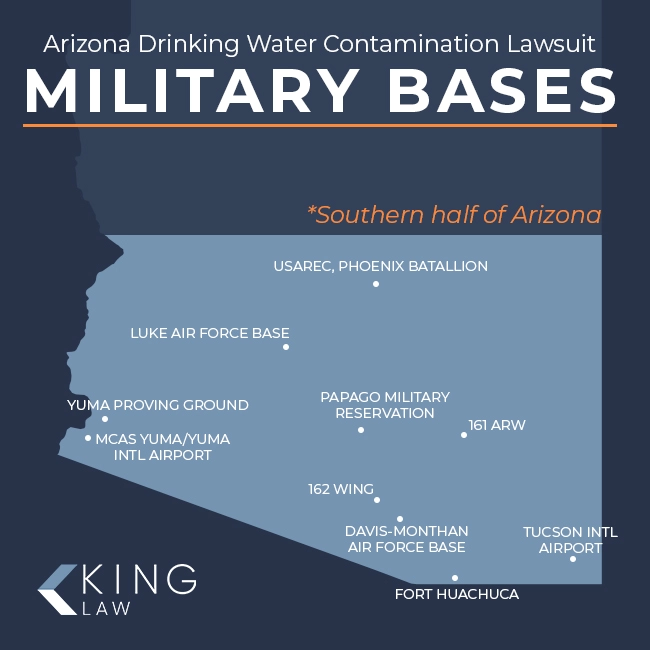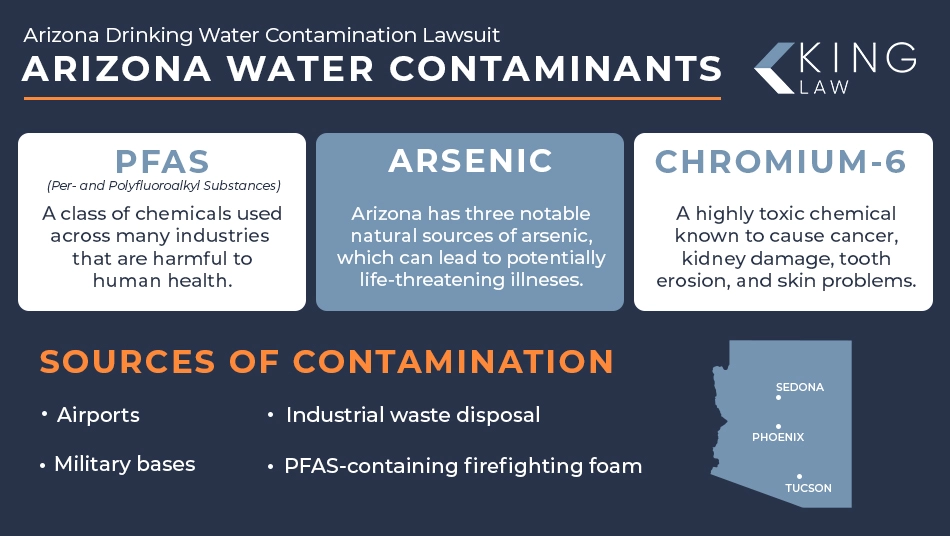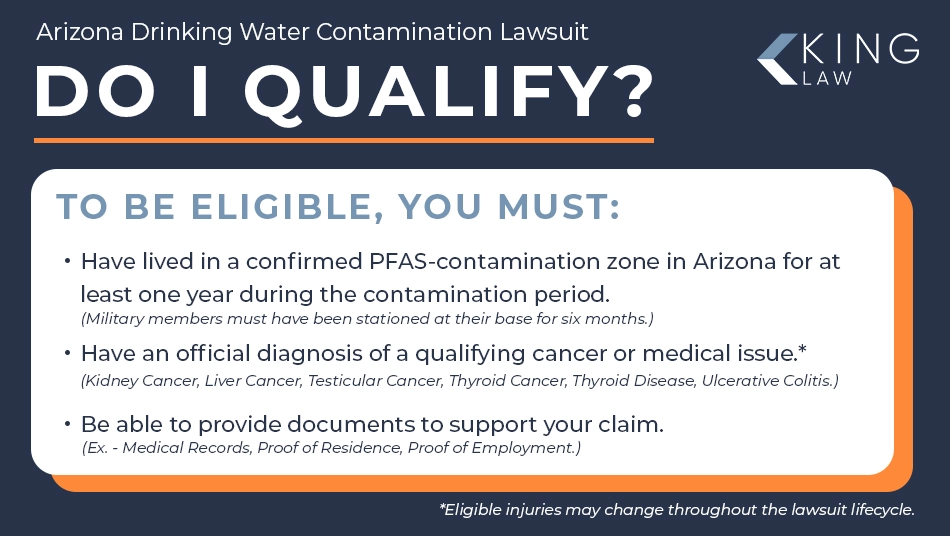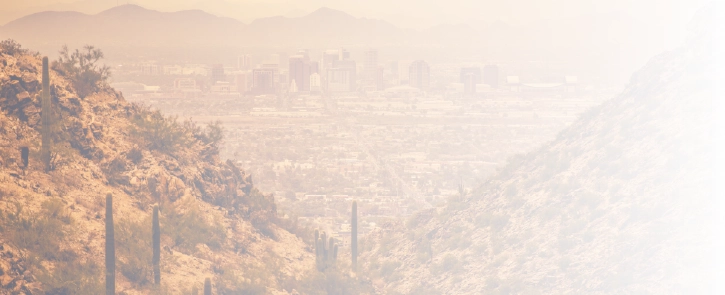
Public reports have shown that Arizona’s drinking water supplies are contaminated with PFAS, a cancer-causing substance used in products like firefighting foam and nonstick cookware. Military installations and airports are the likely culprits for much of the PFAS contamination in Arizona, as these organizations tend to use firefighting foam to put out liquid fuel fires. Residents of Arizona are filing legal claims because they developed testicular, liver, kidney, and thyroid cancer, thyroid disease, or ulcerative colitis after drinking water with these toxins in it. Arizona officials have not yet passed PFAS regulations; however, they are testing the state’s water supplies and are complying with the EPA’s ongoing efforts to curb PFAS in the water supplies.
Arizona Water Contamination Lawsuit Overview
Many residents of Arizona have discovered that their drinking water may be polluted with per- and polyfluoroalkyl substances (PFAS). PFAS, also called forever chemicals, are a group of hundreds of human-made substances commonly used in plastics, firefighting foam, nonstick cookware, or waterproof gear. These chemicals have been in use since the 1940s, and many research studies have confirmed they are hazardous to human health and can cause cancers and other diseases.
The USEPA and the Arizona Department of Environmental Quality have alerted the public that PFAS have been detected in several wells throughout Arizona. For example, according to public reports, the drinking water sources around Tucson International Airport and Luke Air Force Base had concerning levels of PFAS. Since Arizona is home to four desert regions and relies on groundwater sources for public water, it is crucial that its water supplies are kept clean.
Armed with the truth about their water quality, many people in Arizona are taking the fight to court. They are filing lawsuits to tell their stories, help protect others, and secure the settlement they need to repay their losses.
Timeline of Water Contamination in Arizona | 2025 Update
August 6, 2025: Arizona DEQ Receives $5M in Funding to Address PFAS Contamination
The Arizona Department of Environmental Quality has received $5 million in funding through the American Rescue Plan Act to assess PFAS contamination in Arizona. The funds will be used for multiple initiatives, including groundwater testing at priority contamination sites, testing on up to 20 existing groundwater monitoring wells, the installation of new groundwater monitoring wells, continued site-specific investigation, and community outreach. Water sampling will occur at Tucson (Shannon Road/ El Camino del Cerro and a combined Miracle Mile and Silverbell Landfill site), Gilbert (Cooper Road and Commerce Avenue and South Mesa), Phoenix (West Osborn Complex), Lake Havasu City (Lake Havasu Avenue and Holly Avenue), and Prescott (Miller Valley Road and Hillside Avenue). Depending on the results of the testing, PFAS remediation may be needed at these sites. Drinking water in surrounding areas may also be contaminated.
May 14, 2025: EPA Unveils New Action Plan for PFAS in Drinking Water in America, Including Arizona
The EPA announced that it would enforce the same maximum PFAS limits set by the previous presidential administration. As part of its PFAS action plan, the EPA will establish programs to help people who own small, private, or rural wells meet the PFAS compliance levels. Additionally, the EPA intends to review GenX PFAS (including PFNA and PFHxS) and issue regulations as needed under the Safe Drinking Water Act.
October 22, 2024: The US Air Force and Arizona National Guard Achieve PFAS Compliance
The EPA has determined that the US Air Force and Arizona National Guard are now in compliance with the Safe Drinking Water Act regulations. In May 2024, the EPA notified these organizations that their operations in Arizona were contaminating the drinking water with PFAS. These organizations worked with the EPA and other agencies to develop an approved plan to reduce PFAS in the water and limit further contamination of other water sources.
May 29, 2024: Tucson International Airport Area Required to Take Steps to Limit PFAS in Arizona Drinking Water
The EPA has notified the US Air Force and Arizona National Guard that the Tucson International Airport Area is in violation of the Safe Drinking Water Act. The EPA’s enforcement order requires these agencies to take steps to keep PFAS out of the environment. As part of this, these organizations must create and submit an action plan for how they intend to protect the public from the PFAS being released from the Tucson International Airport Area.
June 2023: Arizona Unveils Strategy to Reduce and Monitor PFAS in the Water
Arizona’s Department of Environmental Quality (ADEQ) published its strategy to help improve water quality by decreasing PFAS levels. As part of this, Arizona intends to create transparent and practical solutions (such as water testing) to make sure everyone in Arizona knows what is in their water. Additionally, the Arizona government helped fire departments by replacing and safely throwing away over 9,000 gallons of AFFF firefighting foam.
About the Arizona Water Contamination
Arizona Water Contamination Lawsuit Overview
Timeline of Water Contamination in Arizona | 2025 Update
Sources of Water Contamination in Arizona
Arizona’s Regulations for Drinking Water
Contaminants Found in Arizona Drinking Water
Current Water Quality in Arizona
Health Risks and Symptoms Linked to Drinking Water in Arizona
Eligibility Criteria for the Arizona Water Contamination Lawsuit
Arizona Water Contamination Settlement and Payout Amounts
How to File an Arizona Water Contamination Lawsuit
Statute of Limitations for Arizona Water Contamination Claims
Sources of Water Contamination in Arizona
Arizona’s Department of Environmental Quality (ADEQ) reports that about 6% of Arizona’s tested water sources (like public and private wells) have PFAS levels that are at or above the health advisory levels set by the EPA, meaning 94% tested were in compliance. A number of activities can pollute the water sources in Arizona. For example, debris and residue from airports can seep into the groundwater. Likewise, military operations may use materials and equipment, such as PFAS-containing firefighting foam, that can also release PFAS chemicals into the air.
Improper and proper waste disposal efforts can also allow PFAS in plastics, nonstick items, rainproof gear, and human sewage to enter groundwater sources.
Water Contamination From Military Installations
For decades, military bases in Arizona used aqueous film-forming foam (AFFF) to put out fires from liquid fuel. However, it was discovered that AFFF contained forever chemicals and was polluting the air, soil, and water in and around military bases. For example, in 2021, authorities discovered that Luke Air Force Base had unsafe levels of PFAS in the water supplies in and around this installation. Likewise, Davis-Monthan Air Force Base has also been flagged as a significant source of PFAS contamination.
There are other military installations in Arizona, some of which may have used or currently use PFAS-containing firefighting foam. The Military Installations directory lists the following locations, each of which is a possible source of PFAS contamination:
- Davis-Monthan Air Force Base
- Fort Huachuca
- Luke Air Force Base
- MCAS Yuma
- USAREC, Phoenix Battalion
- Yuma Proving Ground
- 161 ARW
- 162 Wing
Some of these installations have been found to have startlingly high levels of PFAS. Here are the test results for a few military listings:
- Marine Corps Air Station Yuma (2019): 4,770 ppt (PFHxS)
- Tucson International Airport (2019): 4,970 ppt (PFOS and PFOA)
- Papago Military Reservation (2021): 4,430 ppt (PFHxS)
The Tucson International Airport Area (TIAA) Superfund site has been flagged as an area of high concern because it is near a source of drinking water for up to 600,000 people.

Arizona’s Regulations for Drinking Water
Currently, Arizona does not have any state-level regulations for PFAS levels in its water systems. However, Arizona monitors its drinking water reservoirs and has taken steps to limit contamination in high-use supplies. For example, in 2021, the City of Tucson and the Arizona government cut off the Tucson International Airport Area from the Tucson drinking water supply. Arizona is also tracking and following EPA regulations as they are issued and updated.
The federal EPA regulates public drinking water supplies in Arizona. The EPA’s current enforceable limits for PFAS include the following:
- PFOA – 4 parts per trillion
- PFOS – 4 parts per trillion
- PFHxS – 10 parts per trillion
Arizona has cooperated with the EPA to decrease the contamination of its water sources. Arizona also publishes the results of its water quality testing data online. Even though it does not have state-level PFAS regulations in place, Arizona is taking steps to make sure its wells do not have more than the EPA’s maximum.
Contaminants Found in Arizona Drinking Water
Arizona’s drinking water supplies have been contaminated with various substances. The largest sources of contamination are PFAS, arsenic, and chromium-6. All of these can pose significant health risks to the human population in Arizona, including cancer and thyroid disease.
Per- and Polyfluoroalkyl Substances (PFAS)
Per- and polyfluoroalkyl substances are commonly recognized by their acronym, PFAS, or their nickname, forever chemicals. These substances are used in the military, agricultural, and culinary sectors. The primary source of PFAS contamination in Arizona is military installations that use aqueous film-forming foam to put out fires from liquid fuel. PFAS has been put into AFFF products because they do not change their chemical properties when they interact with water. These activities caused hundreds of gallons of PFAS to seep into the soil and groundwater in Arizona, putting thousands of people at risk.
The International Agency for Research on Cancer (IARC) has classified some types of PFAS as carcinogenic to humans and harmful to human health. PFAS have been linked to a number of diseases and cancers. They do not break down easily in the environment or our bodies.
Because of this, these chemicals can build up, especially in our kidneys, liver, bladder, and thyroid, which interrupts how our bodies normally function. For example, excess PFAS in the bloodstream has been associated with testicular cancer and thyroid cancer.
Arsenic
Arizona is home to three natural sources of arsenic, which have caused many of Arizona’s water supplies to have high amounts of arsenic. Drinking water with too much arsenic in it can cause cancer, skin and teeth problems, nausea, and numbness. Arizona’s authorities recommend that people do not drink water with arsenic levels of 10 ppb or higher. They also encourage people to use the Be Well Informed tool to see what their water test results mean in terms of their health.
Chromium-6
Arizona is also one of the few states in the USA with high levels of chromium-6 in its water. As noted by OSHA, chromium-6 (hexavalent chromium) is highly toxic and is known to cause cancer, kidney damage, tooth erosion, and skin problems. According to the Environmental Working Group, the City of Phoenix had the highest chromium-6 levels in its drinking water (an average of 7.853 parts per billion) out of 23 of the United States’ most populated cities.

Current Water Quality in Arizona
Arizona does not have state-level regulations for how much PFAS can be in drinking water sources. However, state and municipal officials are taking proactive steps to curb the levels of PFAS in water supplies. They have tested hundreds of water sources in the state and are actively working to make sure those sources are in compliance with EPA regulations. Residents can use the interactive PFAS testing results map published by the Arizona Department of Environmental Quality to see what the PFAS levels are for their drinking water. The Department also has another water contamination map that discusses the levels of other substances in Arizona’s wells.
Water Treatment Efforts in Arizona
Arizona has spearheaded several efforts to keep Arizona’s water supplies clean and safe. For example, the City of Tucson published a PFAS action plan in 2020 to limit the levels of this contaminant in its drinking water. As part of this, they redirected known sources of contamination (like the Tucson International Airport) so that those sources did not continue to pollute drinking water. There are several Superfund sites in Arizona (including the Luke Air Force Base), and efforts to clean up the drinking water in those regions are ongoing. Although Arizona does not regulate PFAS through state legislation, it expresses a continuing commitment to follow EPA guidelines as those are released and updated.
Health Risks and Symptoms Linked to Drinking Water in Arizona
Studies suggest that the PFAS in Arizona’s drinking water has been causing many residents to become sick. For example, a 2025 research article noted that PFAS exposure can raise someone’s cancer risk by up to 33 percent. Some of the cancers on the list included those of the thyroid, blood, and soft tissues. Blood cancers include leukemia, Hodgkin lymphoma, multiple myeloma, and non-Hodgkin lymphoma. The Keck School of Medicine also reports that PFAS may cause or contribute to kidney, breast, and testicular cancers.
Another study conducted by Yale found that PFAS can cause cancer cells to migrate (move) to other parts of the body. The researchers noted that colorectal cancer (cancer of the colon or rectum) is common among firefighters who regularly interact with PFAS in firefighting foam. PFAS can also increase someone’s risk of prostate, bladder, and liver cancer, as well as someone’s chances of having ulcerative colitis or thyroid disease.
Eligibility Criteria for the Arizona Water Contamination Lawsuit
People in Arizona who developed serious diseases from contaminated water can join or file a water contamination lawsuit if they can show they meet the eligibility criteria. Some of the requirements to file an Arizona PFAS claim include the following:
- Exposure to PFAS: The person was exposed to PFAS because they lived, worked, or were stationed in Arizona for at least one year (or lived on a contaminated military base for at least six months).
- Diagnosis: The person was diagnosed with a cancer that is associated with PFAS exposure.
- Evidence: The person should have sufficient supporting evidence to prove that they qualify for a settlement.
Our law firm is accepting Arizona PFAS cases where victims have been diagnosed with:

Arizona Water Contamination Settlement and Payout Amounts
The settlement that someone may receive if they win their Arizona water contamination lawsuit depends on what occurred in their situation. Some attorneys estimate potential payouts to be up to $30,000 to $300,000; however, this is not a guarantee. Victims with severe losses or those who have a well-supported claim for damages may receive a higher compensation package.
How to File an Arizona Water Contamination Lawsuit
Here are some of the steps involved in filing an Arizona water contamination lawsuit:
- Talk to a lawyer to learn if you may qualify for a compensation package
- Gather evidence needed to support your legal claim
- Write a complaint (the document that starts the lawsuit) and file your PFAS lawsuit in the proper court
- Request evidence from the organization that contaminated your water supply
- Discuss settlement options with the help of your lawyer
It is a good idea to partner with a legal team with years of experience supporting victims who have cancer or diseases because of toxins in their water supplies. They can help you complete the above steps and maximize your chances of winning your claim for compensation.
Evidence to Support Your AZ Water Contamination Claim:
When bringing your Arizona water contamination claim, you need to have evidence to support your legal arguments. For example, you can submit copies of your property, military, or employment records showing that you were exposed to contaminated water in Arizona for at least a year. Additionally, you can locate and present your medical documents to prove that you were diagnosed with a condition that is related to PFAS exposure. Water quality test results would also be useful, as these can show that your water was contaminated with PFAS.
Statute of Limitations for Arizona Water Contamination Claims
You need to make sure you file your Arizona water contamination case before the statute of limitations expires. The length of time you have to bring your lawsuit depends on several factors, including the law of the state where you live. If you miss the filing deadline, you may not be able to receive a settlement, even if you would have qualified for one if you had filed your case on time. There are exceptions, however, that could give you additional time. A lawyer is a reliable resource for determining what your specific deadlines are for requesting a payout.
Arizona Water Contamination Lawyers
Public reports have revealed that military operations, airports, and businesses have been contaminating Arizona’s drinking water with PFAS. PFAS are known to increase someone’s likelihood of developing cancer and several diseases.
If you lived Arizona and developed cancer, your drinking water may be to blame. Get in touch with King Law today by dialing (585) 496-2648 or contacting us online. We welcome the opportunity to give you a free case evaluation and personalized recommendations on what legal options may be available to you.
Frequently Asked Questions (FAQs)
Learn more about water contamination in Arizona with answers to these frequently asked questions:

